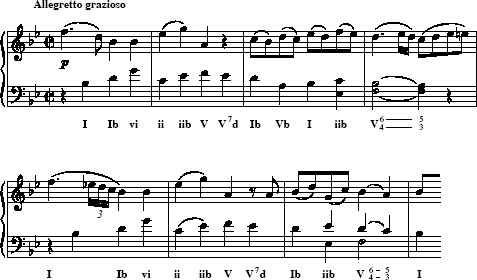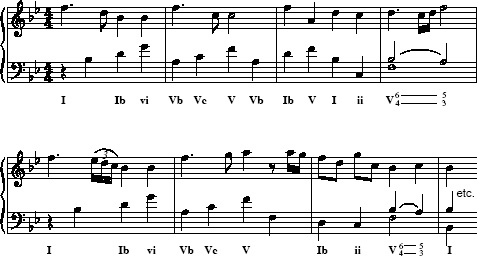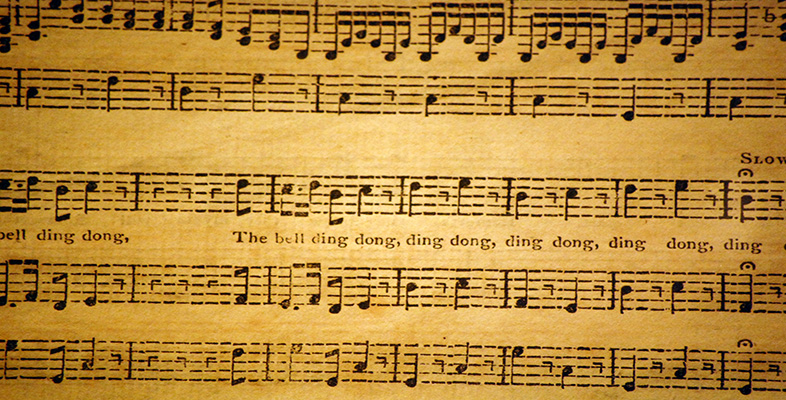2 What is voice leading?
2.1 Two examples
To approach this question, I want you to listen first to two examples. The first is the opening phrase from the beautiful and deceptively simple finale of Mozart's Piano Sonata in B flat, K333. The second is a hypothetical version of my own, similar in some respects but, as you will hear, quite different in effect.
Activity 2
Listen carefully to the recordings of the two passages below, following the music in Examples 1 and 2 also below. The examples are marked with roman numerals to identify the chords used in each. Make a list of the musical features that these examples share. What are the differences in effect between Mozart's version and mine? Which is more logical and satisfying, and why?
Click to listen to passage 1

Click to listen to passage 2

Discussion
At first glance, the two passages have much in common. Both are eight bars long, and in each case the phrase structure is regular: four bars leading to an imperfect cadence, and another four leading to a perfect cadence.
The chord structure, too, is almost identical in each case, consisting primarily of chords I and V, coloured with the use of chord ii and also submediant inflections (the hint of chord vi, G minor, in the second half of bar 1 and bar 5). The melodic lines, while different, contain a mixture of steps and leaps. Isolated from the accompaniment, it would be quite difficult to explain objectively why one melodic line was more logical and satisfying than the other.
Yet I hope you agree that Mozart's example sounds sublimely logical, with the elegance and easy-going predictability (in the best sense) that we tend to associate with Mozart's mature style, while the second is the musical equivalent of doggerel: the harmony seems correct but the effect is awkward and comical. To put it bluntly, Mozart's theme sounds ‘right’; my theme sounds just plain ‘wrong’. Certainly, my attempt could never pass for Mozart.
The roman numeral chordal analysis cannot differentiate adequately between Mozart and my pale imitation, so it has failed to explain an important aspect of Mozart's style. But what can explain the difference between the two extracts?
The answer lies not in chords as such (that is, vertical sonorities considered in isolation). Rather, the differences between these two extracts are found in the large-scale lines that underpin Mozart's melody and bass, giving them a sense of order and coherence that we do not find in my unlovely example.
These musical lines are sometimes described as ‘linear motion’ of individual parts or ‘voices’ within the harmony. In order to show how this linear motion works, I have given a reduced form of the melody below (Example 3). If we remove the grace notes (written-out appoggiaturas and so on) and other dissonant pitches, we can see that the Mozart melody is actually a fleshed-out version of a linear, contrapuntal skeleton.
Activity 3
Listen again to the first phrase of Mozart's melody above, and then to this reduced form of bars 1–4.

Click to listen to the reduced form of bars
Discussion
The F on which the melody starts seems to fall logically to the E♭ in the next bar, while the A (bar 2) leads upwards to the B♭ at the start of bar 3. After all, the A here functions as the leading note (supported by the dominant seventh), and it is the normal tendency of leading notes to lead upwards to their tonics in such situations. Meanwhile, the E♭, left hanging in the air in bar 2, would be expected to fall to a D after the dominant seventh in bar 2 (being the seventh of the chord). Mozart gives us this D in bar 3, thus completing a line F—E♭—D stretched over three bars. A similar kind of linear logic controls both treble and bass movement in the whole extract.
This sort of linear process, where the musical foreground can be seen as the elaboration of underlying lines moving contrapuntally in treble and bass, is what is generally known as ‘voice leading’. The musical surface may proceed by leaps, but is controlled by linear, step-wise movements at a deeper level. In order to show this, I used a simple kind of reduction in Example 3. To put it simply, I have tried to show that, in the language of tonality, some notes are more structurally significant than others: that tonal music operates within a sort of hierarchy in which the ‘skeleton’ underpins the ‘surface’ and gives it cohesion and order. The treble and bass parts can each be called a ‘voice’, and in this ‘skeleton’, each note ‘leads’ by step to the next.
By contrast, my ‘bad’ example (Example 2) contains several imperfections of voice leading. The leading note (A) at the end of bar 2 in the bass feels slightly awkward, because it does not lead to the tonic note; the same is true of the A in the treble in bar 3, which leaps unconvincingly to the D (the third of the next chord). Instead of Mozart's elegant sweeping downward treble line that spans the first phrase, my example repeats the top F in every bar, so that the melodic line lacks flow. You may have spotted several other similarly unconvincing moments in my pastiche.
To summarise: Mozart's theme makes sense not just as theme and accompaniment, but as counterpoint. By ‘counterpoint’ I mean the motion of melodic lines against one another, rather than imitative polyphony. By contrast, my theme is merely a series of chords with a randomly superimposed upper line. The roman numeral analysis, while undoubtedly useful, cannot really deal with this underlying linear aspect of Mozart's music.
